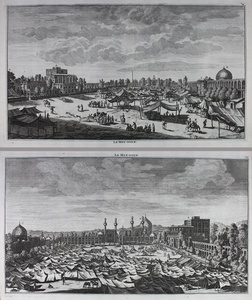| Method | Copper engraving |
| Artist | Cornelis de Bruyn |
| Published | [Delft: Henrik van Krooneveld 1698] |
| Dimensions | Image 205 x 368 mm, Plate 213 x 378 mm, Sheet 330 x 394 mm |
| Notes |
Two views of a large market square in Ispahan, Iran, seen from the North and South, flanked by the Ali Quapu palace (Sublime Gate) on one side and the Masjid-i-Sjah-Lutfullah mosque on the other. From Cornelis de Bruyn's travel book Reizen van Cornelis de Bruyn, door de vermaardste deelen van Klein Asia, de eylanden Scio, Rhodus, Cyprus, Metelino, Stanchio, &c., mitsgaders de voornaamste steden van Aegypten, Syrien en Palestina (1698) Cornelis de Bruyn (1652-1726/7) was a Dutch artist and traveller, born in the Hague. He made two large tours and published illustrated books with his observations of people, buildings, plants and animals. During his first tour, he visited Rome, Egypt, Jerusalem and Cyprus, where he stayed among the Dutch merchants in Smyrna and Constantinople. From 1684 he worked in Venice with the painter Johann Carl Loth, returning in 1693 to The Hague, where he sold his souvenirs. In 1698 he published his book with drawings, which was a success and was translated in several languages. Among his drawings were the first pictures of the interior of the Great Pyramid and Jerusalem that became known in Europe. During his second tour in 1701 he visited the Samoyeds in northern Russia. In Moscow he became acquainted with emperor Peter the Great; de Bruijn painted his nieces, and the paintings were sent to possible candidates for marriage. In late April 1703, De Brujin left Moscow along with the party of an Armenian merchants from Isfahan. De Bruijin and the Armenians sailed down the Moscow River, the Oka and the Volga, eventually reaching Astrakhan. Leaving the borders of the Russian state, de Brujin arrived to Persia, where he made drawings of towns like Isfahan and Persepolis (1704–1705). He continued to Java and returned to Persia, Russia, and ultimately the Netherlands. His drawings of Persepolis, a city destroyed by Alexander the Great, caused a sensation. They were the best prints available to western scholars. De Bruyn's second book, Reizen over Moskovie was not such a success, as he was accused of plagiarism. De Bruyn died in Utrecht. It is not known when and where he was buried. Condition: Excellent, crisp impressions. Pressed vertical centre folds as issued. Tear to the lower margin of the South view, not affecting image. |
| Framing | unmounted |
| Price | £225.00 |
| Stock ID | 43570 |

